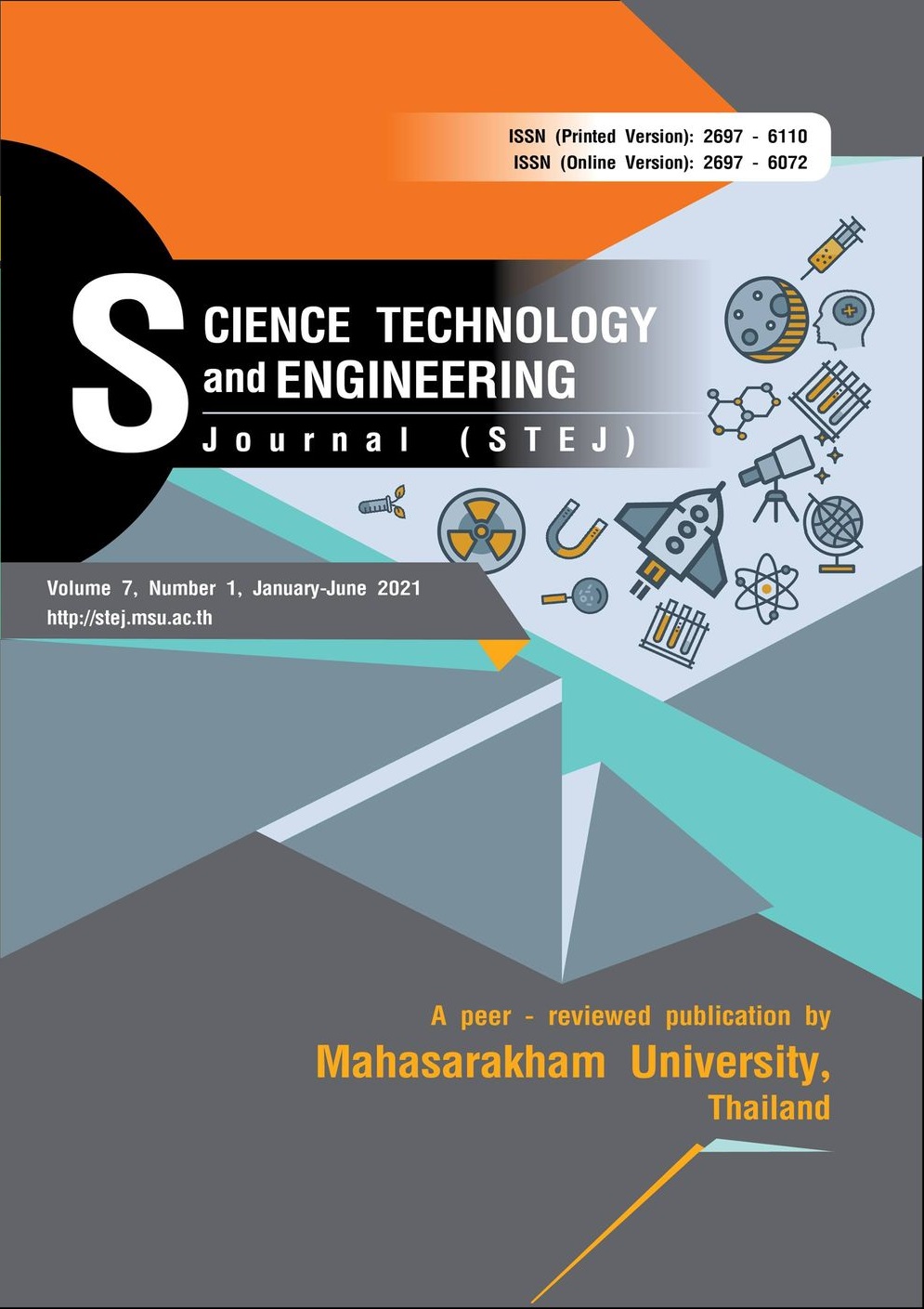Colloidal Properties of the Rice Wine Residue of Thai Purple Rice and its Effects as a Stabilising Agent in Foams
Keywords:
rice wine residue, Thai purple rice, stabilizing agent, foamAbstract
Research toward food waste valorisation has been an attractive subject and aligned with the UN’s Sustainable Development Goal (SDG) 12.3 aiming at drastic reduction of the ecological footprint via minimizing food losses by 2030. In this context, we draw our research focused on upcycling the rice wine residue (RWR) into a value-added ingredient. This study aimed to identify the colloidal properties of RWR and explore its potential application as a stabilising agent for foams or bubbles. Ultrasound treatment was employed at 20 kHz for 30 minutes to breakdown the rice grain and refine the particulates into smaller sizes. The particle sizes of RWR were characterized via Mastersizer and resulted in bimodal distribution with sizes of 0.12 and 27 μm. The surface net charge was found to be around -7.8 ±0.5 mV as measured via Zetasizer. The residue was dried and incorporated into a model foam system using 0.5 wt.% sodium caseinate to initiate the bubble formation. RWR at 0.5 wt.% has shown its ability to retain a stable foam over time for more than 6 hours. To conclude, RWR may potentially be deemed as a foam stabiliser via Pickering stabilization at the bubble interface.
References
Atkin, N., Cheng, S., Abeysekera, R. & Robards, A. (1999). Localisation of amylose and amylopectin in starch granules using enzyme-gold labelling. Starch-Stärke, 51 (5), 163-172.
Bartell, F. (1958). Foam stability. a fundamental investigation of the factors controlling the stability of foams. Journal of the American Chemical Society, 80 (11), 2916-2916.
Binks, B. & Horozov, T. (2005). Aqueous foams stabilized solely by silica nanoparticles.Angewandte Chemie International Edition, 44 (24), 3722-3725.
Chatthongpisut, R., Schwartz, S. & Yongsawatdigul, J. (2015). Antioxidant activities and antiproliferative activity of thai purple rice cooked by various methods on human colon Cancer cells. Food Chemistry, 188, 99-105.
Ellis, A., Norton, A., Mills, T. & Norton, I. (2017). Stabilisation of foams by agar gel particles. Food Hydrocolloids, 73, 222-228.
Embley, B. & Grassia, P. (2006). Mechanisms for the onset of convective instability in foams. Philosophical Magazine Letters, 86 (6), 385-394.
Fameau, A. & Salonen, A. (2014). Effect of particles and aggregated structures on the foam stability and aging. Comptes Rendus Physique, 15 (8-9), 748-760.
Gaewsondee, T. & Duangkhamchan, W. (2019). A novel process for preparing instant riceberry using fluidized bed drying assisted with swirling compressed-air: kinetic aspects. Food and Bioprocess Technology, 12 (8), 1422-1434.
Guilbert, S. and Gontard, N. (2005). Agro-polymers for edible and biodegradable films: Review of agricultural polymeric materials, physical and mechanical characteristics. In: Han, J. (Ed). Innovations in Food Packaging (pp.263-276). Elsevier Academic Press.
Hackbarth, J. (2006). Multivariate analyses of beer foam stand. Journal of the Institute of Brewing, 112 (1), 17-24.
Horozov, T. (2008). Foams and foam films stabilised by solid particles. Current Opinion in Colloid & Interface Science, 13 (3), 134-140.
Jain, S. & Anal, A. (2017). Bioprocessing of beverage industry waste for value addition. In Food Processing By-Products and Their Utilization (pp.295-307).
Jakubczyk, E. & Niranjan, K. (2006). Transient development of whipped cream properties. Journal of Food Engineering, 77 (1), 79-83.
Lam, S., Velikov, K. & Velev, O. (2014). Pickering stabilization of foams and emulsions with particles of biological origin. Current Opinion in Colloid & Interface Science, 19 (5), 490-500. Volume 7, Number 1, January-June 2021 Colloidal Properties of the Rice Wine Residue of Thai Purple Rice and its Effects as a Stabilising Agent in Foams67
Liu, D., Zhang, H., Xiong, W., Hu, J., Xu, B., Lin, C., Xu, L. & Jiang, L. (2014). Effect of temperature on chinese rice wine brewing with high concentration presteamed whole sticky rice. BioMed Research International, Special issue 2014, 1-8.
Lo, B., Gorczyca, E., Kasapis, S., & Zisu, B. (2019). Effect of low-frequency ultrasound on the particle size, solubility and surface charge of reconstituted sodium caseinate. Ultrasonics Sonochemistry, 58, 104525–104525.
Monégier du Sorbier, Q., Aimable, A. & Pagnoux, C. (2015). Influence of the electrostatic interactions in a pickering emulsion polymerization for the synthesis of silica–polystyrene hybrid nanoparticles. Journal of Colloid and Interface Science, 448, 306-314.
Nawaz, M., Fukai, S. & Bhandari, B. (2016). In situ analysis of cooking properties of rice by thermal mechanical compression test method.International Journal of Food Properties, 20 (5), 1174-1185.
Okabe, M. (1979). Texture measurement of cooked rice and its relationship to the eating quality. Journal of Texture Studies, 10 (2), 131-152.
Ratseewo, J., Warren, F. & Siriamornpun, S. (2019). The influence of starch structure and anthocyanin content on the digestibility of Thai pigmented rice. Food Chemistry, 298, 124949.
Ravindran, R. & Jaiswal, A. (2016). Exploitation of food industry waste for high-value products. Trends in Biotechnology, 34 (1), 58-69.
Raymundo, A., Empis, J. & Sousa, I. (1998). Method to evaluate foaming performance. Journal of Food Engineering, 36 (4), 445-452.
Sanchez, C. & Patino, J. (2005). Interfacial, foaming and emulsifying characteristics of sodium caseinate as influenced by protein concentration in solution. Food Hydrocolloids, 19 (3), 407-416.
Wani, A.A., Singh, P., Shah, M.A., Schweiggert-Weisz, U., Gul, K. & Wani, I.A. (2012). Rice starch diversity: effects on structural, morphological, thermal, and physicochemical properties—a review. Comprehensive Reviews in Food Science and Food Safety, 11 (5), 417-436.
Zacharof, M. 2016. Grape winery waste as feedstock for bioconversions: applying the biorefinery concept. Waste and Biomass Valorization, 8 (4), 1011-1025.
Downloads
Published
How to Cite
Issue
Section
License
Copyright (c) 2021 Science Technology and Engineering Journal (STEJ)

This work is licensed under a Creative Commons Attribution-NoDerivatives 4.0 International License.








